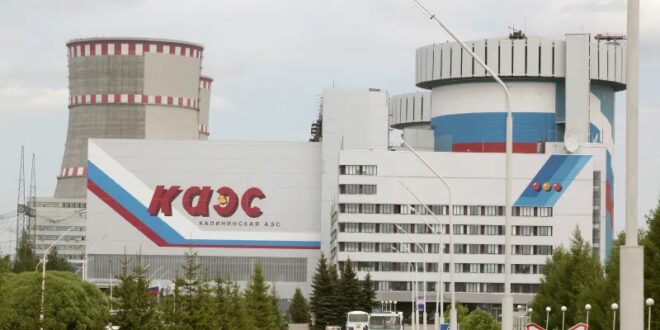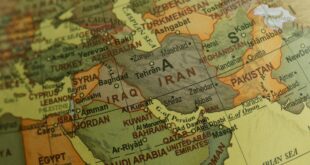The West Is Dependent on Moscow for More Than Just Gas and Oil
The invasion of Ukraine has thrust the world into an energy crisis. Since Russian troops began pouring across the country’s borders, oil prices have risen by more than a quarter. Gas prices have nearly doubled. And the outlook for both markets is not promising; as Western countries use sanctions to limit Russia’s ability to finance its war with oil and gas revenues, energy prices are likely to remain high and volatile. The wartime uncertainty is dovetailing with concerns about climate change, prompting further anxiety about the world’s energy future. Countries needed to start shifting away from fossil fuels decades ago to protect the planet. Now, they must do so at a time when people are paying increasingly high prices.
As states look to bring down high energy costs and disentangle themselves from Russia—while combating climate change—many have expressed a renewed interest in nuclear energy. It’s easy to see why. Nuclear power is already one of the world’s largest sources of carbon-free energy, responsible for 25 percent of the European Union’s electricity. Unlike most forms of renewable energy, such as solar and wind, nuclear power can reliably produce large quantities of electricity every hour of the year. And it has already helped Europe move away from fossil fuels extracted elsewhere in the world, including natural gas from Russia.
But in the short term, increasing Europe’s reliance on nuclear energy won’t free the continent from Russian fuel. Just as Europe has become dependent on Russian oil and gas, so too has much of the world become dependent on Russia for the materials needed to make nuclear power. Russia has close to half of the global capacity to enrich uranium for nuclear fuel, and 40 percent of the nuclear energy produced in Europe depends on uranium from Russia or Kazakhstan and Uzbekistan, both close allies of the Kremlin. Roughly half of all U.S. nuclear power plants—about 10 percent of total U.S. electricity generation—are powered by imports from those three countries (a fact that could explain why the U.S. nuclear industry lobbied to exclude uranium from sanctions on Russian energy imports.) Russia also dominates the market for nuclear power plant exports and construction, especially in emerging economies. Its closest competitor is China, another autocracy. States that contract with China or Russia could spend decades dependent on them for nuclear fuel and services.
To end Russia’s dominance over the nuclear business (and prevent China from taking its place), democratic countries need to get serious about supporting their domestic nuclear industries—especially as new, innovative technologies hit the market. They must implement policies that create demand for nuclear energy as part of their broader climate agendas, and they need to invest in creating nuclear manufacturing facilities that can reliably supply a growing global market. Doing so is critical both to fighting climate change and curtailing the global power of authoritarian regimes.
RUSSIAN POWER
Over the last two decades, Russia has become the world’s go-to supplier for nuclear technology, especially for countries building their first nuclear projects. Russia is deeply experienced in constructing and maintaining nuclear plants, and it offers a one-stop-shop for the items needed to create them: reactors, fuel, financing, and even worker training. Since 2000, Russia has signed bilateral nuclear cooperation agreements with 47 countries, and it has large power plants under construction in Bangladesh, Belarus, and Turkey. It is involved in nuclear projects across Africa, Asia, the Middle East, and South America.
It also has projects in eastern Europe. Indeed, for decades, one of Russia’s main nuclear clients was Ukraine. Before Russia first invaded the country in 2014, Ukraine got 95 percent of its nuclear fuel from Russia—a majority of its entire electricity supply. But after Russia annexed Crimea and fostered an insurgency in the Donbas, Ukraine accelerated plans to diversify its uranium imports. Many other European countries also began expressing concern about being dependent on Russian nuclear technology, worries that were validated in February 2022. Since then, the West has moved quickly to try to wean itself from Russian energy resources, including nuclear power. On May 2, for instance, a Finnish consortium announced it was canceling a contract for a 1,200-megawatt Russian reactor.
Almost all green energy sources present ethical dilemmas.
Of course, Europe’s most prominent dependence is ultimately on Russian coal, oil, and gas, rather than on nuclear energy. In fact, in its guidance for how countries can best move off Russian fuel, the International Energy Agency highlighted the role that nuclear power could play. As the IEA noted, nuclear energy is “the largest source of low emissions electricity in the EU,” and its expansion could substantially increase the continent’s access to fossil-free energy. Not everyone agrees; the European Commission’s plan to reduce Russian gas imports notably does not mention nuclear power, and Germany has held fast in its plans to close its three remaining nuclear reactors by the end of this year (even though the country imported close to $10 billion euros worth of fossil fuels from Russia since the start of the invasion). But other countries, such as Belgium and Japan, have promised new investments in nuclear energy to reduce their dependence on Russian gas. They are picking up on an old tradition of using nuclear power to bolster energy independence. Countries with dwindling domestic coal supplies, like the United Kingdom and Japan, turned to nuclear energy after World War II to fuel their growing industrial sectors. After the oil embargoes of the 1970s, France and Sweden also built out nuclear infrastructure to reduce their dependence on the Middle East.
Although nuclear power is critical to freeing Europe from Russian gas, it could still leave these states vulnerable to Russian influence. And even if states cancel nuclear projects with Russia, China will soon surpass France to become the second-largest producer of nuclear power, with its own ambitions for dominating the global export market.
Indeed, almost all green energy sources present ethical dilemmas. The Democratic Republic of Congo currently makes 60 percent of the world’s cobalt—a mineral critical to electric vehicles—but the country’s producers have faced scrutiny from international organizations over human rights practices, including their use of child labor. In 2021, the Biden administration blacklisted several Chinese solar companies after they were accused of using forced labor and other abuses. And Russia is a significant producer of nickel, which is critical to electric vehicle batteries. Concerns over future sanctions on nickel, or other disruptions to its supply, have driven its price to an 11-year high.
CHAIN REACTION
To free itself from dependence on Russian energy, the world will need to be more proactive in ensuring that its energy supply chains are sustainable and ethical. But that doesn’t mean a return to energy isolationism. Modern energy production systems are complex and interconnected, especially those that depend on critical minerals not evenly distributed across the globe. They indicate that true energy independence—where states create power entirely by themselves—is no longer practical. Instead, democracies should focus on strengthening their energy interdependence with trusted partners.
To some extent, this process is already underway with nuclear power. Romania canceled an agreement with a Chinese state-owned firm in 2020 for two nuclear reactors because it preferred to move forward with a NATO ally. China and Russia had been in the running for a nuclear tender in the Czech Republic, but the government ultimately excluded them from a formal document-sharing process and explicitly said that both states were “not invited” to bid. Chinese firms are significant investors in two nuclear power projects in the United Kingdom. Yet in September of 2021, the British government announced it was trying to force a sale of China General Nuclear Power Group’s share in one of the projects. In 2019, a U.S. nuclear company co-founded by Bill Gates announced that it had canceled a project to build an experimental reactor in China after U.S. President Donald Trump imposed further trade restrictions.
True energy independence is no longer practical.
But the West’s domestic nuclear industries have stalled in recent years, and so right now, U.S. and European nuclear companies are struggling to find proper alternatives to Russian and Chinese state-owned vendors. To catch up, their governments must craft an old-fashioned industrial policy based on investing in domestic manufacturing capabilities all along the nuclear supply chain. They will have to successfully demonstrate new nuclear technologies that they can then market globally. That means Western countries should increase funding for nuclear export projects through their own export-import banks and development financing, and also by pushing large investment and development banks to change their policies on supporting nuclear power.
Doing this will not be easy, and it will not be inexpensive. But the West’s drive will benefit from its dynamic and innovative nuclear sector. Although traditional, large-scale nuclear projects have struggled domestically in the United States and Europe, a new suite of nuclear technologies could start to shift the market in their favor. The United States has over 60 companies working on advanced reactor technologies, including NuScale Power, which is marketing small modular reactors and has reached agreements to deploy them to Poland and Romania. (The latter country has also agreed to import reactors from Canada.) The British company Rolls Royce is working to develop its own small modular reactor technology, and it has signed memorandum of understanding with the U.S. utility Exelon and entities in the Czech Republic. Westinghouse, a U.S. nuclear energy company that helped Ukraine dramatically reduce its reliance on Moscow, has also recently expanded its cooperation with the Czech Republic (and Slovenia) to explore deploying its newer, large AP1000 reactors. And in April, the U.S. State Department announced that it would help Latvia explore the feasibility of nuclear power.
These kinds of collaborations across allied democracies are precisely what the planet needs to create energy supply chains that are secure, ethical, and sustainable. They will help the West build resilience against the whims of authoritarian regimes. By pivoting away from fossil fuels, they will also help states avoid supply shortages and price shocks. But these collaborations show a recognition that the solution to Russia’s energy dominance and to climate change is not an attempt at green nationalism. Instead, it requires that allied states work together to design energy systems and technologies that are robust because they are collaborative and interdependent.
 Eurasia Press & News
Eurasia Press & News




